The Seven Wonders of the World that caught the attention of ancient civilizations have not stood the test of time, with one exception.
Only one of the listed structures has survived to this day, the majestic Great Pyramid of Giza. We can only know the rest from history books.
The same list is from B.C. It appeared thanks to the ancient Greek mathematician Philo of Byzantium, who lived in the third century. Being an excellent mechanical and military engineer, he traveled a lot and even worked in Rhodes and Alexandria. Scientists believe that he is its author Seven Wonders of the World From the work entitled, which contains descriptions of outstanding buildings of the time, reported by Greek correspondent.
Many magnificent structures have met a similar end, so we can only learn about these wonders of the world from historical sources.
Hanging Garden of Semiramis
Hanging Garden of Semiramis. Source: Wikimedia Commons
According to legend, the Hanging Garden astonished people with its splendor and engineering prowess. Despite their widespread popularity, they remain almost legendary structures. Gardens are mentioned only in the works of ancient authors. Archaeologists have not yet been able to determine the location of the garden or any trace of its existence.
Researchers disagree about the origin of this grandiose structure. According to one version, II. It was built by the Babylonian king Nabu Koduri-usur to entertain his wife, Queen Amitis. According to another theory, the garden was built by Queen Semiramis, who was in the year BC. He ruled in Babylon in the ninth century.
The garden consists of four levels. Each floor had balconies and balconies entwined with plants hanging down to the ground.
After the fall of Babylon, the plants withered and the magnificent structure was destroyed by repeated earthquakes. However, the artistic representations still remind us of the splendor of the Hanging Garden.
Statue of Olympian Zeus

Statue of Olympian Zeus. Source: Wikimedia Commons/Kansaliskergasto
The huge statue of the Lightning Lord is made of the finest wood, ivory and precious metals. The ancient Greeks called the statue the embodiment of male beauty. Zeus sat on a luxurious throne worthy of the chief of the gods.
The best Athenian sculptor, Phidias, was responsible for creating the work. According to one myth, when he finished the work and asked Zeus if he was satisfied with it, lightning struck the marble floor. This represents a positive response.
However, the masterpiece has not survived to this day. It is believed that the statue went to Constantinople, where it burned to the ground in a terrible fire.
Statue of Rhodes

Colossus of Rhodes. Source: Wikimedia Commons/Martin van Heemskerk
In the coastal city of Rhodes, BC. In 280, a huge statue appeared to welcome the arrivals. It rose high above the rooftops, and travelers could see the light of its torch from miles away.
The statue was a memorial to the sun god Helios, and took twelve years to complete and consumed tons of bronze.
However, the statue lived a short life, remaining in place for only sixty years. An earthquake in 226 BC knocked the giant off his feet and sent him straight into the sea.
Mausoleum of Halicarnassus

Mausoleum of Halicarnassus. Source: Wikimedia Commons/Ferdinand Knapp
This building was commissioned by the tyrannical King Mausolus, hence the word “mausoleum”. He wanted to build himself the best tomb in the world, and he himself invented the structure of the future eternal shelter.
Mausolus’s vision was to provide the most luxurious building superior to any temple. He was able to realize his dream with the help of famous architects. The shrine was a huge structure decorated with columns and hundreds of statues of gods, warriors and animals.
Compared to the other wonders on this list, the burial chamber is long lasting. twelveth. And the fifteenth. However, it was destroyed by a series of huge earthquakes in the 20th century.
Temple of Artemis

Temple of Artemis in Ephesus. Source: Wikimedia Commons/Philip Galli
At the site of the Temple of Artemis in Ephesus, today only one column stands alone in the barren wasteland. There were 127 of them, giant columns arranged in nine rows, which supported the magnificent sanctuary.
The interior decoration of the church was equal to its stunning exterior splendor. Sculptures of masters, paintings by famous artists, gold, wood and marble. In the middle stood a statue of the goddess herself.
Unfortunately, the church only lived for six centuries. It has been badly damaged throughout history, sacked by the Goths and submerged by raging waves, and almost nothing remains of it.
Pharos Lighthouse

Pharos Lighthouse. Source: Wikimedia Commons
According to legend, an architect named Sostratus of Knidos came up with the idea of creating a structure that would help sailors navigate. He himself supported this ambitious project. Five years later, there was already a unique building on the island of Pharos.
The Lighthouse of Alexandria had more than just a practical role. His majestic appearance was proof of what man was capable of. Later, the lighthouse also played an important role in various military conflicts.
However, this wonder of the world also met a tragic fate. It was damaged by several earthquakes until one finally destroyed the lighthouse.
The Great Pyramid of Giza is the only work that remains to the mind

Hufu pyramid. Source: Wikimedia Commons/Nina (CC BY-SA 3.0)
The Egyptian pyramids attract tourists from all over the world, giving them the opportunity to see the oldest of the Seven Wonders of the World with their own eyes. This unique building is about 4,500 years old.
The modern appearance of the pyramid differs significantly from the original, as it has undergone several renovations. However, when looking at the architectural masterpiece, we almost return to ancient Egypt. One can only imagine the deep respect that surrounded the pharaoh.
It took twenty years to build the pyramid. At the time, this was a huge undertaking. The Pharaoh’s family invested generously in materials and labor. Historians estimate that about one hundred thousand people worked on the tomb. They managed to create an incredible pyramid, which for a long time was the tallest structure in the world.
Worth reading:











































